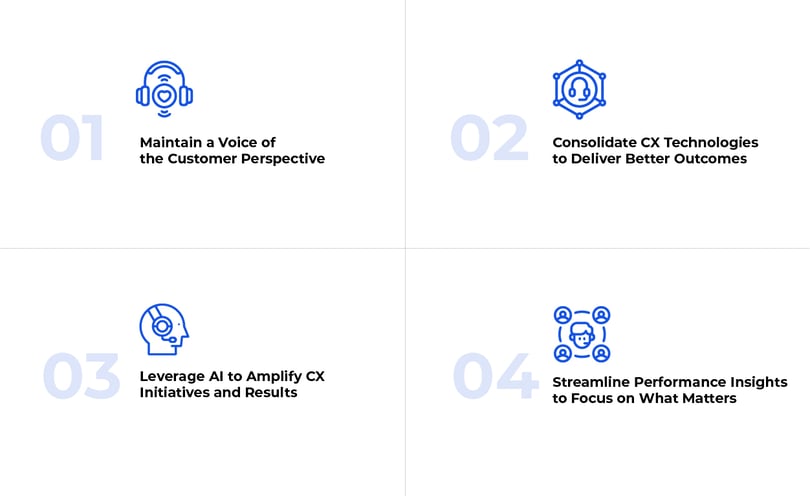As organizations around the globe accelerate their digital transformation, customer experience (CX) is a critical focus for today’s enterprises. Every interaction a customer has with an organization shapes their brand perception and loyalty, ultimately impacting whether they will come back for repeat purchases or turn to a competitor. Serving as the frontline for every customer interaction is the contact center, actively shaping the customer journey and affecting everything from customer satisfaction scores to retention rates. By examining how the contact center influences the customer journey, we can gather valuable insights into the customer experience, helping to implement best practices to drive better service. In this blog, we’ll cover why the customer experience is so important and how to leverage the four pillars of CX success in your favor.
What is Customer Experience (CX)?
Customer experience, also known as CX, is the sum of all interactions a customer has with an organization across various touchpoints, such as voice, email, SMS, social media, or in person. These interactions are handled by the contact center, making it a pivotal player for CX optimization.
Research shows that perfecting the customer experience is well worth an organization’s investment and attention. A great customer experience can result in improved customer retention and loyalty, deeper brand affinity, and opportunities to up-sell or cross-sell.
These recent data points and statistics illustrate why:
- Organizations with a customer-centric strategy see 60% higher profits than those that don’t prioritize CX.
-
Around 83% of U.S. customers consider good customer service an important or critically important driver of brand loyalty.
-
As much as 48% of consumers state they are willing to pay more to receive quality customer service.
-
46% of consumers purchase more from an organization if offered a personalized experience.
-
73% of consumers agree the customer experience affects their purchasing decisions.
An exceptional customer experience is a point of competitive differentiation worth fighting for. While the majority of today’s business leaders agree CX optimization is of high priority, as low as 6% of brands are increasing their customer experience quality. According to research, “80% of managers think they are meeting or exceeding customer expectations for access to live agents. But only 37% of consumers agree.” That's a significant and damaging misunderstanding of the state of things.
So, how can your enterprise close this “delivery gap” and start delivering the customer experience that your clientele expects? The answer lies in the four pillars of CX Success.
Four Pillars of a Successful Customer Experience

#1: Maintain a Voice of the Customer Perspective
Every decision your organization makes, whether it is client-facing or not, should take into account the customer and their experience. What do they think about your brand? How do they feel when they interact with your agents? And what do they tell their friends, family, and colleagues? As Gartner states, “Strong, sustainable customer relationships start with understanding customer experience (CX) value from the customer’s point of view.” Getting to know your customers starts with fostering a mindset where every interaction, whether through voice, SMS, email, etc., is seen as an opportunity to learn more about wants, needs, and processes to eventually exceed expectations.
Implementing contact center capabilities such as CSAT scores, customer surveys, speech analytics, and sentiment analysis can help your organization gain in-depth insights into how your customers feel, and how your agents handle their interactions. With AI-powered and automated insights into tone of voice, engagement trends, keyword usage, and more, it becomes easy for supervisors to identify key areas of contact center improvement needed to optimize outcomes and customer experiences.
But why is this needed? By investing in these types of automated insights, your organization is provided with a comprehensive view of both your customers and your agents. This creates an invaluable opportunity to develop customized agent training programs to promote empathy, active listening, and problem-solving skills based on the identified needs of your customers. Simply put, when aligning every aspect of contact center operations against the goal of enhancing the customer experience, your organization can create a culture where customer satisfaction is at the core of the company's DNA.
#2: Consolidate CX Technologies to Deliver Better Outcomes
Organizations house incredible amounts of information about their customers — from purchase history to account information to previous interactions. Nevertheless, this information may not necessarily be easy to access or comprehend, especially if it is siloed in different departments or across disparate systems and communication channels. While contact information is commonly stored in an organization’s system of record — such as ServiceNow, SAP, Salesforce, or Microsoft Dynamics — customer interactions are managed through the contact center. In recent research, Gartner reports, “Functional silos create fragmented, disjointed processes and experiences throughout the customer life cycle, introducing risk and negatively impacting customer trust.” When the contact center platform operates in a siloed environment from remaining systems, it leaves agents and supervisors with limited customer insights, leading to poor customer support.
To truly exceed expectations and enhance the customer experience, agents and supervisors need a single view of their customers to understand the full journey. A simple yet powerful solution is to integrate all client data across SaaS solutions, CRMs, and database management platforms into a single-pane-of-glass. This provides your support teams with a more adequate understanding of each customer and their unique needs. Instead of swivel-chairing between platforms to access customer data and engagement insights, a contact center solution embedded within your system of record helps consolidate engagements with customer records, creating a complete picture of the customer’s needs and requirements. Agents are empowered with a user-friendly workspace where voice and SMS channels are available through the CRM or service management platform, while supervisors have easy access to real-time, comprehensive customer and agent information needed to drive proactive customer service.
#3: Leverage AI to Amplify CX Initiatives and Results
Gartner predicts that “By 2026, conversational artificial intelligence (AI) deployments within contact centers will reduce agent labor costs by $80 billion.” While there are multiple use cases for AI in the contact center, some of the most common field applications today include:
Voice Self-service:
Harnessing the power of Conversational AI and Natural Language Understanding, virtual agents can understand and resolve repetitive customer requests (i.e., password reset, latest ticket update, etc.) in a personalized, human-like manner without leveraging live agents in each instance.
AI-powered Speech Analytics:
Instead of relying on 1-2% of manually audited calls, speech analytics provides automated call transcriptions and insights into 100% of customer engagements to empower supervisors to quickly spot sentiment trends, keywords, etc., at scale.
GenAI Auto-call Summarization:
The average agent spends 6 minutes post-call entering manual notes — assuming they enter any at all. Automate agent note-taking, leveraging machine learning to quickly summarize each customer interaction while creating more reliable data entries for future reference or review.
#4: Streamline Performance Insights to Focus on What Matters
Information and technology are essential to delivering great customer service, but if your organization is not giving its employees the tools and guidance they need, this will undoubtedly be a challenge. After all, agents — answering phone calls, inquiries, and service requests — are essentially the face of your organization. With advanced capabilities, such as automated call transcriptions and AI Coaching, supervisors can seamlessly provide agents with curated training and actionable guidance backed by data powered by 100% of their customer interactions instead of a sample set of manually audited calls. With AI Coaching, actionable feedback is provided automatically — and in real-time — based on performance. When your agents are set up for success, improved CX comes seamlessly. Well-trained agents equipped with the right tools will deliver more efficient and personalized customer service.
WATCH: In this video, we'll cover how reporting and dashboards integrated with the service management platform — in this case, ServiceNow — will help optimize performance, leading to better customer experiences.
Keep Your Customers Engaged With A Strong Experience At Every Touchpoint
Today's customers prioritize experiences above everything else, and enterprise organizations must follow suit to keep up. By incorporating these four pillars of successful CX into your customer experience management strategy, your business can attract and retain happy and loyal customers. For more information, check out the blog “Top 5 CX Strategies to Optimize Your Contact Center in 2024" or visit the 3CLogic website.




